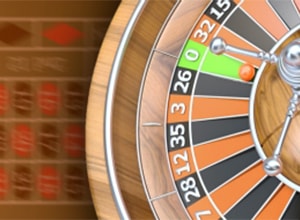There are hundreds of strategies that exist in the gambling world and most of them have been developed for specific games. When it comes to casino games of chance, however, it is impossible to come up with a strategy that will guarantee you a win. Instead, players, roulette experts and even mathematicians have created betting systems that focus on the betting theory and the bankroll management. And one of the easiest, most frequently used roulette systems in the world today is the d’Alembert system.
It bears the name of an influential French mathematician and philosopher who lived in the 18th century. Along with its many contributions to the science of his time, Jean le Rond d’Alembert became known for defending what we call today ‘gambler’s fallacy’, the mistaken belief that if something has not happened in a while, it is due to happen soon. Whether you believe in it or not (and most reasonable gamblers today do not), you may find the d’Alembert system quite useful when playing roulette. It is designed for placing even-money bets such as red/black, even/odd and high/low.
- Up to $3000 welcome bonus upon first three deposits
- Well-established US-friendly brand
- Top quality casino games
- Extra bonuses for Bitcoin depositors
 ACCEPTED
ACCEPTED
PLAYERS FROM UNITED STATES: OHIO ARE ACCEPTED AT THIS CASINO
- Well-established brand
- Prompt payments
- 24/7 customer support
- Wide range of casino games
 ACCEPTED
ACCEPTED
PLAYERS FROM UNITED STATES: OHIO ARE ACCEPTED AT THIS CASINO
- Up to $300 bonus upon first three deposits
- Great loyalty program
- Superb loyalty program
- Great selection of table games
 ACCEPTED
ACCEPTED
PLAYERS FROM UNITED STATES: OHIO ARE ACCEPTED AT THIS CASINO
- Accepts players from all over the world
- Great daily bonuses
- Fair bonus rules and requirements
- Award-winning customer care team
 ACCEPTED
ACCEPTED
PLAYERS FROM UNITED STATES: OHIO ARE ACCEPTED AT THIS CASINO
Unlike the famous Martingale system, for instance, it does not require you to double your bet after each losing spin. Instead, it stipulates that the bet is increased gradually over time. Further down, you can see how exactly the d’Alembert Roulette System works and whether it is suitable for you. Interestingly, this system can be used for a wide variety of games that feature even-money bets – roulette players are just some of the many gambling enthusiasts who can benefit from it.
What You Need to Know about the d’Alembert Roulette Strategy
 Let me start by saying that this system is very simple to understand, so if you are a fairly inexperienced roulette player you should definitely keep reading and see if it might be for you. This system uses linear progression; that is, after a win or loss, the next bet is increased or decreases by a FIXED amount. This can be compared to the Martingale system, for example, which doubles your bet after a loss instead, requiring a much higher bankroll.
Let me start by saying that this system is very simple to understand, so if you are a fairly inexperienced roulette player you should definitely keep reading and see if it might be for you. This system uses linear progression; that is, after a win or loss, the next bet is increased or decreases by a FIXED amount. This can be compared to the Martingale system, for example, which doubles your bet after a loss instead, requiring a much higher bankroll.
As you will see, there are both benefits and cons to the d’Alembert roulette system, but before I get into those it would be beneficial for you to understand how the system works in the first place.
How It Works
The concept is incredibly simple, but there is some sound logic behind it, as I shall explain. The system is used for all outside bets in roulette which pay evenly. As a negative progression, it adds 1 unit to the size of your bet each time you lose. When you win, it reduces your bet by 1 unit. For those who are unsure what I mean by a ‘unit’, a unit is any number, so it could be £5, £100, or of course just £1.
To start using the system, you need to place a bet of one unit on any even chance bet such as red or black. Of course, the chance is not exactly 50/50 on these bets, but the payout is as if it was. If you lose this initial bet, then your next bet will increase by one unit. When you win, the following bet will decrease by one unit. Continue like this until you end up with a net profit of one unit.
To better illustrate the method, let us take an initial bet of £1 on black. The wheel spins, the ball hits red, so you lose and increase your second bet to £2. You lose again and the third bet you need to place is £3. You win the spin and therefore, your next bet decreases to £2. Very simple, right?
The Concept
The idea behind the d’Alembert roulette system is to recoup your losses by increasing your bet after each loss. It’s the same principle as in the Martingale roulette system, but bets increase linearly making this system considerably safer. The flipside of this strategy in comparison to the Martingale, however, is that more wins are, of course, needed to result in a net profit.
Similarly to many other betting systems, this method is based on the notion that if red wins more than black, then black is more likely to win in the future. And if red wins less now, it is more likely to win in the future. The idea is that the frequency of the two bets will eventually balance out. Of course, red and black are equally likely to win in each spin, but as their appearance is random, such balance can be reached after an infinite number of spins. In reality, roulette is random and as we can see, this principle should not be valid, yet, some avid roulette players rely on it and build their strategy based on this belief.
Of course, for most players, d’Alembert will remain simply a useful, relatively safe and simple betting system that will help them manage their bankroll a little more effectively. Not to mention the fact that, after all, following a certain strategy, even a simple one such as this, is much more fun than placing your chips aimlessly on the table.
A Closer Look at the d’Alembert System
 So just how many wins does it take after a certain amount of losses to make a profit? Generally speaking, you only need 2 wins every 5 spins to make a net profit. This ratio isn’t set in stone and increases with the number of losses in the round (although only marginally). The round can continue for a really long time when using this system – it will take you longer to reach the table limit or to go bankrupt. That is why most players reset the progression when they achieve a net profit, even if it is a small one.
So just how many wins does it take after a certain amount of losses to make a profit? Generally speaking, you only need 2 wins every 5 spins to make a net profit. This ratio isn’t set in stone and increases with the number of losses in the round (although only marginally). The round can continue for a really long time when using this system – it will take you longer to reach the table limit or to go bankrupt. That is why most players reset the progression when they achieve a net profit, even if it is a small one.
At this stage, you may be thinking that the system sounds pretty good in theory; bet more when you lose so that it’s easier to make a profit. But there is a flaw in increasing your bet by a fixed amount, which becomes apparent during long rounds. Let’s say you lose your initial bet of one unit, your next bet will, of course, be two units, double your original bet. This means that a win here dramatically outweighs your initial bet and so you have a net profit. Even with three losses, a bet of four units is still significant. But as the round goes on, a bet of 21 say, after 20 losses, isn’t so significant and the system falls apart; the number of wins needed increases as the round drags on.
Where this system shines is during a game with frequent alternations between wins and losses, or a game which doesn’t go on for too long. To explain these points more clearly, I’ve listed a couple of examples below, along with a short explanation.
Short Rounds
Before going into more detail, you should understand that in this context, ‘round’ means not a single spin, nor your entire session on the table. It refers to the number of spins you include in one progression. In this scenario, you can see that only two wins are needed compared to three losses to make a total profit. This is always good to see. The system excels in these short and snappy rounds, and the increase of a unit after a loss is comparable to the size of the bet.
Long Rounds
Here we have a longer round, with some reasonably long losing streaks involved. I have tried to demonstrate here that as the round continues and the bets become large, the increase of a unit after each loss becomes increasingly insignificant (to show this properly I would have had to create a pretty large table, but don’t be fooled, you will encounter much longer rounds than the one shown here with much higher bets). The system starts to break down, and the ratio of wins to losses gets smaller to make a profit. In this scenario, the Martingale fairs much better.
There are even worse examples where you can lose twice as much, but it is also possible to generate good profits from such long rounds. All you need is luck – at the right time. In the table below, you can see another scenario which may seem rather unlikely at first sight, but you can be sure that it is still possible. Remember, in gambling, anything can happen – even if you think it is extremely unrealistic.
| Spin | Bet | Win/Lose | Profit |
|---|---|---|---|
| #1 | 1 | Lose 1 | -1 |
| #2 | 2 | Lose 2 | -3 |
| #3 | 3 | Lose 3 | -6 |
| #4 | 4 | Lose 4 | -10 |
| #5 | 5 | Win 5 | -5 |
| #6 | 4 | Win 4 | -1 |
| #7 | 3 | Win 3 | 2 |
| #8 | 2 | Win 2 | 4 |
| #9 | 1 | Win 1 | 5 |
Reverse l’Alembert Roulette System
Also known as Contre l’Alembert, this system functions in the same way as the original method, only the other way round. Instead of increasing the bet after a loss, you increase it after a win – once again, by a fixed amount of one unit. This reverse variation of the method is very similar to another strategy, known as the Oscar’s Grind system. You can read more about it in a dedicated article on this website.
When using the reverse l’Alembert, you will stop playing the current round when you reach a net profit or any predetermined profit. Unfortunately, this version also cannot guarantee consistent winnings, especially in longer rounds. In the tables below, you can see a couple of examples, which clearly show how this system can be favourable to the player sometimes, and quite the opposite in other instances.
| Spin | Bet | Win/Lose | Profit |
|---|---|---|---|
| #1 | 1 | Lose 1 | -1 |
| #2 | 1 | Lose 1 | -2 |
| #3 | 1 | Lose 1 | -3 |
| #4 | 1 | Lose 1 | -4 |
| #5 | 1 | Lose 1 | -5 |
| #6 | 1 | Win 1 | -4 |
| #7 | 2 | Win 2 | -2 |
| #8 | 3 | Win 3 | 1 |
| #9 | 4 | Lose 4 | -1 |
| #10 | 3 | Win 3 | 2 |
| #11 | 4 | Win 4 | 6 |
| #12 | 5 | Win 5 | 11 |
| Spin | Bet | Win/Lose | Profit |
|---|---|---|---|
| #1 | 1 | Win 1 | 1 |
| #2 | 2 | Win 2 | 3 |
| #3 | 3 | Win 3 | 6 |
| #4 | 4 | Loss 4 | 2 |
| #5 | 3 | Loss 3 | -1 |
| #6 | 1 | Win 1 | 0 |
| #7 | 2 | Loss 2 | -2 |
| #8 | 1 | Win 1 | -1 |
| #9 | 2 | Win 2 | 1 |
| #10 | 3 | Win 3 | 4 |
| #11 | 4 | Loss 4 | 0 |
| #12 | 3 | Win 3 | 3 |
| #13 | 4 | Loss 4 | -1 |
| #14 | 3 | Win 3 | 2 |
| #15 | 4 | Loss 4 | -2 |
| #16 | 3 | Loss 3 | -5 |
Is the System Right for You?
 So I guess the question is, should you use the d’Alembert roulette system? Well, like any betting system, there are pros and cons one should take into consideration. It would be wrong to assume that longer rounds always end up in huge losses if this system is used.
So I guess the question is, should you use the d’Alembert roulette system? Well, like any betting system, there are pros and cons one should take into consideration. It would be wrong to assume that longer rounds always end up in huge losses if this system is used.
It would be also very wrong to believe that when applied in real life, the theory will hold true – it would, only if you play an infinite number of bets and spins. So, before choosing this method, you should look closely at the advantages and disadvantages it offers.
Advantages
On the plus side, only a relatively small bankroll is needed compared to quite a few systems, due to the linear progression. Of course, no roulette betting system can be completely safe, but compared to most strategies, the d’Alembert is as safe as possible. The win to lose ratio can be appealing, and short and snappy rounds, even with more losses to wins, can see the player quickly come out with a nice profit. This system is also recommended for inexperienced players as it is rather simple to use and helps limit the losses.
Disadvantages
The cons are certainly noteworthy though. As I have demonstrated (or at least tried to), a long round sees the system crumble, and can leave the player down on money with a long way to go before he or she wins it back. And after all that trouble, ultimately the player is only up one unit. Of course, with a little bit of luck and a nice winning streak, the d’Alembert may earn you great profits. Once again, as with all roulette systems, punters should be very careful and determine the right size of their bets. Otherwise, they may end up losing huge amounts of funds and once they reach the table limit (or they run out of money), they will have no way of recouping their losses.
In short, I wouldn’t say that the d’Alembert roulette system is one of my favourites and certainly not one I tend to use. If you are looking for a system to play regularly, this isn’t it. It can make you a nice little profit in a short amount of time, so is certainly worth trying out, but don’t expect it to make you rich in the long run.





